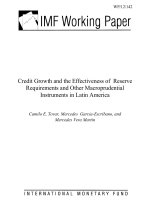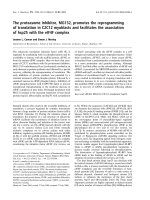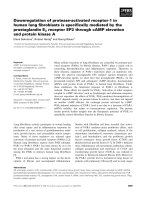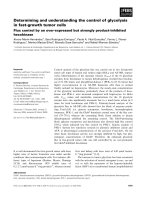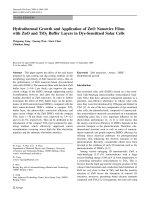Downregulation of MiR-203a disinhibits Bmi1 and promotes growth and proliferation of keratinocytes in cholesteatoma
Bạn đang xem bản rút gọn của tài liệu. Xem và tải ngay bản đầy đủ của tài liệu tại đây (1.33 MB, 9 trang )
Int. J. Med. Sci. 2018, Vol. 15
Ivyspring
International Publisher
447
International Journal of Medical Sciences
2018; 15(5): 447-455. doi: 10.7150/ijms.22410
Research Paper
Downregulation of MiR-203a Disinhibits Bmi1 and
Promotes Growth and Proliferation of Keratinocytes in
Cholesteatoma
Jian Zang, Lian Hui, Ning Yang, Bo Yang, Xuejun Jiang
Department of Otolaryngology, The First Affiliated Hospital of China Medical University, Shenyang 110001, China.
Corresponding author: Prof. Dr., Xuejun Jiang, MD, PhD, Department of Otolaryngology, The First Affiliated Hospital of China Medical University, No.155,
Nanjing Street, Heping District, Shenyang 110001, China. E-mail:
© Ivyspring International Publisher. This is an open access article distributed under the terms of the Creative Commons Attribution (CC BY-NC) license
( See for full terms and conditions.
Received: 2017.08.16; Accepted: 2018.02.04; Published: 2018.03.08
Abstract
Background: Keratinocytes are the predominant cell type in a cholesteatoma, and microRNA
(miR)-203a has been shown to be essential for the growth and differentiation of keratinocytes. The
regulatory mechanisms of miR-203a and Bmi1—the predicted target of miR-203a that is associated
with cholesteatoma—have not been clarified.
Methods: Real-time PCR and western blot were carried out for the detection of miRNAs, mRNAs,
and proteins, including miR-203a, Bmi1, and phosphorylated (p-)Akt. Immunohistochemical staining
was applied to observe the expression and distribution of Bmi1 and of p-Akt in cholesteatoma and
in control retroauricular skin. The dual luciferase reporter assay was used to analyze the
relationship between miR-203a and Bmi1. Ectopic miR-203a and Bmi1 were transfected into an
immortalized line of human keratinocytes (HaCaT cells), and the roles of these molecules in cell
proliferation, apoptosis, and migration were explored.
Results: Cholesteatoma tissues were characterized by downregulation of miR-203a and
concomitant upregulation of Bmi1. Results of the dual-luciferase reporter assay indicated that Bmi1
was a direct target gene of miR-203a. Silencing of miR-203a increased Bmi1 expression; promoted
proliferation, colony formation, and migration of HaCaT cells; and inhibited apoptosis. Moreover,
p-Akt was significantly increased in cholesteatoma tissues and was positively correlated with Bmi1.
Suppression of Bmi1 reduced p-Akt expression in HaCaT cells; subsequent inhibition of miR-203a
reversed this phenomenon.
Conclusions: Our results reveal that miR-203a may regulate cholesteatoma growth and
proliferation by targeting Bmi1. These findings provide insight for the development of novel
nonsurgical options for cholesteatoma.
Key words: cholesteatoma, microRNA, microRNA-203a, B-cell specific moloney murine leukemia virus insertion
site 1 (Bmi1), p-Akt
Introduction
Middle ear cholesteatoma is a wellcircumscribed cystic lesion that occurs when a
keratinizing squamous epithelium grows abnormally
in the temporal bone [1]. Cholesteatoma keratinocytes
exhibit proliferation and migration characteristics
akin to a tumor [2, 3], and numerous researchers have
demonstrated upregulation of tumor-related genes
and markers of proliferation in cholesteatoma
specimens [4-7]. Cholesteatoma-associated otitis
media is a common disease in otolaryngology, and the
pathogenesis of cholesteatoma is a topic of intense
research. However, cholesteatoma still is not
understood fully, and a feasible nonsurgical treatment
is lacking for this condition.
Int. J. Med. Sci. 2018, Vol. 15
Micro (mi)RNAs are small noncoding RNA
molecules
that
regulate
post-transcriptional
expression by intervening in the degradation of
mRNA and/or by inhibiting translation; miRNAs
primarily are negative regulators [8]. MiRNAs play
crucial roles in diverse biological processes, including
proliferation,
differentiation,
apoptosis,
and
migration [9, 10]. Investigators previously have
demonstrated that miR-203a is specific to epithelial
tissue; affects the growth, differentiation, and function
of keratinocytes; and is an important contributor to
skin development [11-13]. In many tumors, miR-203a
has been shown to prevent or suppress cancer [14-17].
Like the skin, a cholesteatoma is composed primarily
of keratinocytes; like a tumor, the keratinocytes of a
cholesteatoma exhibit abnormal proliferation and
migration. However, no studies have addressed the
putative contributions of miR-203a and its predicted
target gene in cholesteatoma.
To identify the predicted gene target of
miR-203a, we probed for a stem-associated factor that
was regulated by miR-203a and closely related to cell
proliferation. The B-cell specific moloney murine
leukemia virus insertion site 1 (Bmi1) is vital for
maintaining stemness and self-renewal in normal and
cancerous cells [18, 19]. Bmi1 belongs to the
polycomb-group (PCG) family of proteins. As a
transcriptional inhibitor, Bmi1 can silence gene
expression [19, 20], and results of several studies have
indicated that Bmi1 is an important regulator of
keratinocytes [21, 22]. In the human epidermis, Bmi1
promotes proliferation of keratinocytes and prevents
premature aging and death of these cells [22].
Disorders that affect Bmi1 expression often are
associated with the occurrence and development of
malignant tumors [23]. Overexpression of Bmi1 can
promote abnormal proliferation, invasion, and
metastasis of tumor cells by increasing the level of
phosphorylated (p-)Akt [24-27]. Notably, p-Akt also is
essential in cholesteatoma pathogenesis [28, 29]. The
expression level of Bmi1 in cholesteatoma and the
potential relationship between Bmi1 and p-Akt in
cholesteatoma have not been examined.
In the current study, we found that the
expression levels of miR-203a and Bmi1 are inversely
correlated in cholesteatoma, with miR-203a
downregulated and Bmi1 upregulated. Furthermore,
we demonstrated that Bmi1 is a direct target of
miR-203a. Reduced expression of miR-203a promoted
abnormal proliferation and migration of HaCaT cells
and inhibited apoptosis; silencing of Bmi1 rescued
these functions. We also determined that Bmi1
positively regulates p-Akt in cholesteatoma. Low
expression of miR-203a is essential for the
development of cholesteatoma; this finding may
448
provide insight regarding nonsurgical therapies for
patients with cholesteatoma.
Materials and Methods
Clinical samples
Cholesteatoma
and
retroauricular
skin
specimens that served as control tissues were
obtained from patients (mean age, 45.84 years; age
range, 8-76 years) who had undergone middle ear
surgery at the First Affiliated Hospital of China
Medical University (Shenyang, China) from July 2015
to July 2016. Clinical histories were reviewed for all
patients included in this study. A total of 56
cholesteatoma specimens and 28 retroauricular skin
specimens were collected. These specimens included
20 pairs in which 1 patient provided both a
cholesteatoma and a retroauricular skin sample. This
study was approved by the Ethics Committee of the
First Affiliated Hospital of China Medical University,
and all patients (or the parents of patients younger
than 18 years old) provided written informed consent
prior to surgery.
Polymerase chain reaction
Total RNA was extracted from tissues and cells
using RNAiso plus (Takara Biotechnology, Dalian,
China), according to the manufacturer’s instructions.
To examine the expression of miRNAs and mRNA,
total RNA (including miRNAs) was polyadenylated
by means of E. coli Poly(A) Polymerase (New England
Biolabs, Ipswich, MA) and then was reverse-transcribed (RT) into cDNA using a PrimeScript RT
Reagent Kit with gDNA Eraser (Takara).
Amplification of cDNAs was achieved by quantitative
real-time polymerase chain reaction (qPCR) with
SYBR Premix Ex Taq II (Takara) on a 7500 Real-Time
PCR System (Applied Biosystems, Foster City, CA).
U6 and GAPDH were applied as endogenous
controls. Relative gene expression was calculated in
terms of threshold cycle (CT) values, using the 2−ΔΔCT
method.
The primer sequences were as follows: miR-203a:
5'-GCGTGAAATGTTTAGGACCACT-3';
miR-reverse: 5'-GCTGTCAACGATACGCTAC
G-3'; miR-RT primer: 5'-GCTGTCAACGATACGCTA
CGTAACGGCATGACAGTGTTTTTTTTTTTTTTTTT
TTTTTT-3'; U6 forward: 5'-CTCGCTTCGGCAGCAC
A-3' and
reverse:
5'-AACGCTTCACGAATTTGCGT-3';
Bmi1 forward: 5'-CTGCAGCTCGCTTCAAGATG-3'
and
reverse: 5'-TTAGCTCAGTGATCTTGATTCTCG
T-3'; GAPDH forward: 5'-GTCTCCTCTGACTTCAAC
AGCG-3' and reverse: 5'-ACCACCCTGTTGCTGTAG
CCAA-3'.
Int. J. Med. Sci. 2018, Vol. 15
Cell culture and transfection
An experimental line of human immortalized
keratinocytes
(HaCaT)
was
obtained
from
the Dermatology Key Laboratory of China Medical
University. Cells were cultured in high-glucose
Dulbecco’s Modified Eagle Media (DMEM) (HyClone,
Thermo Fisher, Beijing, China) with 10% fetal bovine
serum (FBS) (Corning, Thermo Fisher, Waltham, MA).
HaCaT cells were grown under sterile, humidified
conditions at 37℃ and 5% CO2. The miR-203a
inhibitor, control miRNA, Bmi1 small interfering
(si)RNA, and control siRNA were synthesized by
RiboBio (Guangzhou, China). They were transiently
transfected into cells using Lipofectamine 3000
reagent (Invitrogen, Carlsbad, CA), according to the
manufacturer’s instructions.
Western blot and immunohistochemistry
Tissues or cells were lysed with RIPA
(radioimmunoprecipitation assay) lysis buffer
containing 1 mM of phenylmethylsulfonyl fluoride
(PMSF). The proteins were separated through a 10%
sodium dodecyl sulfate (SDS) polyacrylamide gel
electrophoresis (PAGE) and were transferred to
polyvinylidene
fluoride
(PVDF)
membranes
(Millipore, Danvers, MA). After blocking, the
membranes were incubated with primary antibody
(anti-Bmi1 and anti-GAPDH [both, Proteintech,
Rosemont, IL]; anti-Akt and anti–p-Akt [both, Santa
Cruz Biotechnology, Santa Cruz, CA]). The results
were visualized using an enhanced chemiluminescence (ECL) detection system (Thermo Fisher).
For immunohistochemistry, sections were
incubated overnight with primary antibody and
subsequently with biotin-labeled secondary antibody.
The specimens were photographed under an inverted
light microscope (Olympus, Tokyo, Japan).
Immunostaining was evaluated in terms of the
product of staining intensity and the percentage of
positive stained cells, as described previously [28].
Staining intensity was scored as follows: 0, no
staining; 1, weak staining; 2, moderate staining; 3,
strong staining. The percentage of positively stained
cells was scored as follows: 0, no staining (negative);
1, <10% stained; 2, 10% to 50% stained; 3, >50%
stained. Both staining intensity and the positivity rate
of staining were analyzed independently by 2
experienced
researchers
under
double-blind
conditions. The results were regarded as negative if
the overall score was ≤2 and as positive if the overall
score was ≥3.
Dual luciferase reporter assay
Luciferase reporter vectors containing the
wild-type or mutant Bmi1 3ʹ untranslated region
449
(UTR) were prepared by RiboBio Co. Ltd.
(Guangzhou, China). For the luciferase reporter assay,
HaCaT cells were seeded in 96-well plates at a density
of 1.5 × 104 cells per well. Following culture for 48
hours, the cells were transiently cotransfected with
miR‑203a mimics/control miRNA and with
Bmi1-3ʹUTR‑wild/Bmi1-3ʹUTR‑mutant
reporter
vectors using Lipofectamine 3000 (Invitrogen),
according to the manufacturer’s instructions. At 48
hours post-transfection, luciferase activity was
evaluated using the Dual-Glo Luciferase Assay
System (Promega, Madison, WI).
Cell proliferation and colony formation
Cells were transfected with a negative-control
miR inhibitor or a miR-203a inhibitor or were
cotransfected with a miR-203a inhibitor and Bmi1
siRNA and were collected 24 hours later. A single-cell
suspension then was prepared and transferred to a
96-well plate. The density was adjusted to 3000 cells
per well, and 5 wells corresponded to each
experimental group. Cell proliferation was detected
using an Infinite M200 Pro Microplate Reader (Tecan,
Männedorf, Switzerland) and a CellTiter 96 AQueous
Single Solution Cell Proliferation Assay Kit (MTS,
Promega). Absorbance was determined at 490 nm
(OD490) daily for 3 consecutive days, and a cell
growth curve was plotted. To assess cell colony
formation, cells were transfected and at 24 hours were
seeded into 6‑well plates at a density of 400 cells per
well. Cells then were incubated for 10 to 14 days with
high-glucose DMEM. When macroscopic colonies
could be discerned, the colonies were counted.
Cell cycle analysis
Cells were transfected and maintained in culture
for 48 hours. Cells then were fixed with 70% ethanol
overnight at 4°C and were incubated with RNaseA at
37°C for 30 minutes. Staining with propidium iodide
(PI) (KeyGen Biotech, Nanjing, China) was carried out
for 30 minutes at 4℃, and cells were analyzed in an
aliquot of 1 × 106 cells by means of flow cytometry
(FACSCalibur, BD Biosciences, Franklin Lakes, NJ).
Cell cycle distribution was expressed as a percentage
of the cells.
Apoptosis assay
Cells were transfected, cultured for 48 hours, and
collected. Cell density was adjusted to 1 × 106
cells/mL. An Alexa Fluor 488 Annexin V/Dead Cell
Apoptosis Kit (Invitrogen) then was applied,
according to the manufacturer’s instructions. The
level of apoptosis was evaluated by flow cytometry
(FACSCalibur, BD Biosciences).
Int. J. Med. Sci. 2018, Vol. 15
Cell migration assay
Cells were transfected and cultured for 24 hours.
Cells then were collected and plated in serum-free
medium (cell density, 2 × 105) in the upper layer of a
transwell insert (Corning). In the bottom layer,
DMEM containing 20% FBS was added, and cells
were incubated for 24 hours. The nonmigratory cells
were scraped from the upper surface with a cotton
swab and discarded. The cells on the lower surface
were fixed with 100% methanol and were stained
with hematoxylin. Migratory cells then were counted
under a microscope (Olympus).
Statistical analysis
Data were expressed as mean ± standard
deviation (SD) from 3 independent experiments.
Statistical significance was determined by a 2‑tailed
Student’s t test or by 1-way analysis of variance
(ANOVA) using GraphPad Prism 7.0 software (San
Diego, CA). Correlations were ascertained by means
of Pearson and Spearman correlation analyses. The
enumeration data were compared by the χ2 test.
Statistical significance was defined as P < 0.05.
Results
Low expression of miR-203a is negatively
correlated with that of Bmi1 in cholesteatoma
We selected and analyzed 3 miRNAs associated
with cell proliferation in specimens from 56 cases of
cholesteatoma and in 28 retroauricular skin tissue
specimens (Supplementary Figure S1). The results of
real-time PCR indicated that only the expression of
miR-203a was significantly lower in cholesteatoma
than in normal retroauricular skin (Figure 1A).
However, the level of miR-203a in cholesteatoma was
not correlated significantly with clinical findings
(Supplementary Table S1).
Twenty
patients
had provided paired
cholesteatoma and retroauricular skin specimens. For
all these cholesteatoma specimens, miR-203a was
found to be significantly downregulated compared to
the paired retroauricular skin sample (Figure 1B,C). In
contrast, Bmi1 levels in paired samples were
upregulated in cholesteatoma specimens (Figure
1D,E). Findings from Pearson correlation analysis
revealed a strong negative correlation between the
expression of miR-203a and that of Bmi1 in
cholesteatoma (Figure 1F). Immunohistochemical
evidence showed that Bmi1 was expressed primarily
in the nuclei and populated nearly the full layer of
cholesteatoma epithelium (Figure 1G). However, in
retroauricular skin, Bmi1 mainly stained the
basal-layer cells and occasionally the suprabasal
layers (Figure 1G). The positivity rate of Bmi1 was
450
80% (16 of 20 specimens) in cholesteatoma and was
35% (7 of 20 specimens) in retroauricular skin (χ2 =
8.286, P = 0.004).
MiR-203a negatively regulates Bmi1 by directly
binding to its 3ʹUTR
To investigate how Bmi1 expression is regulated
by miR-203a, we transfected HaCaT cells with
miR-203a mimics or a miR-203a inhibitor and
measured Bmi1 levels. Bmi1 mRNA and protein levels
in the miR-203a mimic group were significantly
decreased; the opposite findings were obtained in the
miR-203a inhibitor group (Figure 2A,B). To further
verify whether miR-203a directly targets Bmi1, we
prepared wild-type and mutant Bmi1-3ʹUTR reporter
constructs
(Figure
2C).
We
cotransfected
negative-control miR-mimics/miR-203a mimics with
these wild-type/mutant Bmi1-3ʹUTR reporter
constructs into HaCaT cells and tested for luciferase
activity. We determined that luciferase activity was
significantly repressed in cells that had been
cotransfected with the wild-type Bmi1-3ʹUTR reporter
construct and miR-203a mimics (Figure 2D). In
contrast, luciferase activity did not change
significantly when cells were cotransfected with
miR-203a mimics and the mutant Bmi1-3ʹUTR
reporter constructs. Therefore, miR-203a directly
interacts with the binding site of the Bmi1-3ʹUTR and
negatively regulates the expression of Bmi1.
Low levels of miR-203a disinhibit Bmi1
expression and result in proliferation, colony
formation, migration, and reduced apoptosis
of HaCaT cells
To simulate downregulation of miR-203a in
cholesteatoma, we transfected HaCaT cells with a
miR-203a inhibitor and evaluated Bmi1 levels and cell
behaviors. We found significantly increased Bmi1
protein (Figure 3B); enhanced cell proliferation and
clonogenic ability (Figure 3C,D); an increase in the
percentage of cells in the S phase, and a decrease in
the percentage of cells in the G0/G1 phase (Figure
3E); a decrease in the proportion of apoptotic cells
(Figure 3F); and enhanced cell migratory ability
(Figure 3G). All these changes were restored when
HaCaT cells were cotransfected with a miR-203a
inhibitor and Bmi1 siRNA (Figure 3).
Overexpression of p-Akt is positively
correlated with that of Bmi1 in cholesteatoma
Other authors have noted that Bmi1 can elevate
the level of p-Akt in many tumors. We hypothesized
that this regulation also may occur in cholesteatoma.
To test this hypothesis, we examined the expression of
p-Akt in 20 paired cholesteatoma and retroauricular
Int. J. Med. Sci. 2018, Vol. 15
451
skin specimens. The expression of p-Akt was higher
in cholesteatoma than in paired retroauricular skin
(Figure 4A,B). Furthermore, results of Pearson
correlation analysis showed a strong positive
correlation between p-Akt and Bmi1 (Figure 4C).
Immunohistochemistry findings were that p-Akt was
expressed in almost the full layer of cholesteatoma
epithelium and was found predominantly in the
cytoplasm (Figure 4D). In contrast, p-Akt mainly was
expressed in basal-layer cells of retroauricular skin.
The positivity rate of p-Akt expression was 70% (14 of
20 specimens) in cholesteatoma and 25% (5 of 20
specimens) in retroauricular skin (χ2 = 8.120, P =
0.004). We also found a significant correlation in
positive-staining scores for Bmi1 and p-Akt in 20
cases of cholesteatoma (Table 1).
HaCaT cells and detected the expression of Bmi1, total
Akt, and p-Akt by western blot. The results showed
that the expression of Bmi1 protein and p-Akt protein
in the Bmi1 siRNA group were significantly lower
than in the control siRNA group (Figure 4E). When
cells were cotransfected with Bmi1 siRNA and a
miR-203a inhibitor, the expression of Bmi1 and p-Akt
proteins were significantly recovered (Figure 4E).
There were no significant differences in the
expression of total Akt protein among the 3 groups.
MiR-203a regulates p-Akt via Bmi1 in HaCaT
cells
The correlation between Bmi1 and p-Akt expression was ascertained by Spearman
correlation analysis.
Table 1. Positive correlation between Bmi1 and p-Akt expression
in 20 cases of cholesteatoma
Bmi1
Positive
Negative
p-Akt
Positive
13
1
Negative
3
3
r
P-value
0.491
0.028
We transfected control and Bmi1 siRNA into
Figure 1. In cholesteatoma, miR-203a expression is low and is negatively correlated with that of Bmi1. (A) Expression of miR-203a in 56 cases of cholesteatoma and
in 28 normal retroauricular skin specimens was detected by real-time PCR. *P < 0.05. (B) Expression of miR-203a in 20 paired cholesteatoma and retroauricular skin
specimens was ascertained by real-time PCR. (C) Statistical analysis of miR-203a expression (n = 20). *P < 0.05. (D) Western blot results of the expression of Bmi1
in 20 cases of cholesteatoma and in paired retroauricular skin specimens. (C, cholesteatoma; S, corresponding retroauricular skin). (E) Statistical analysis of Bmi1
protein (n = 20). *P < 0.05. (F) Results of Pearson correlation analysis of miR-203a and Bmi1 in 20 cases of cholesteatoma. (G) Immunohistochemical staining findings
of Bmi1 in cholesteatoma and in corresponding retroauricular skin samples (original magnification, ×400).
Int. J. Med. Sci. 2018, Vol. 15
452
Figure 2. Bmi1 is a target gene of miR-203a and is inhibited by miR-203a. MiR-203a mimics, a miR-203a inhibitor, and corresponding negative controls were
transfected into HaCaT cells. (A) Bmi1 mRNA levels were detected by real-time-PCR. *P < 0.05. (B) Bmi1 protein levels were examined by western blot. *P < 0.05.
(C) Predicted binding sites of miR-203a with the 3ʹUTR of Bmi1 and the design of wild-type and mutant Bmi1-3ʹUTR reporter constructs. (D) Into HaCaT cells,
wild-type or mutant Bmi1-3ʹUTR reporter constructs were cotransfected with negative-control miR mimics or miR-203a mimics. Luciferase activities was detected
at 48 hours post-transfection. *P < 0.05.
Figure 3. Inhibition of miR-203a promotes cell proliferation, colony formation, migration, and evasion of apoptosis in HaCaT cells via upregulation of Bmi1. (A) The
interference efficiency of Bmi1 siRNA in human keratinocytes. HaCaT cells were transfected with a negative-control miR inhibitor or a miR-203a inhibitor or were
cotransfected with a miR-203a inhibitor and Bmi1 siRNA. (B) Bmi1 expression was detected by western blot. (C) Cell proliferation was analyzed by the MTS
colorimetric method (Promega). (D) Clonogenic capacity was detected by the colony-forming assay. (E, F) Changes in cell cycle progression and apoptosis were
examined by flow cytometry. (G) Cell migration ability was tested by the transwell cell migration assay. *P < 0.05.
Int. J. Med. Sci. 2018, Vol. 15
453
Figure 4. Overexpression of p-Akt is positively correlated with Bmi1 in cholesteatoma. (A) Western blot analysis of p-Akt, total Akt, and Bmi1 expression in 20
paired cholesteatoma and retroauricular skin specimens (C, cholesteatoma; S, retroauricular skin). (B) Statistical analysis of p-Akt expression from 20 paired
cholesteatoma and retroauricular skin specimens. *P < 0.05. (C) Pearson correlation analysis of p-Akt and Bmi1 in 20 cases of cholesteatoma. (D)
Immunohistochemical staining of p-Akt in cholesteatoma and retroauricular skin (original magnification, ×400). (E) Western blot analysis of Bmi1, total Akt, and p-Akt
expression in HaCaT cells transfected with control siRNA, Bmi1 siRNA, or Bmi1 siRNA + miR-203a inhibitor. *P < 0.05.
Discussion
Investigators have demonstrated that miR-203a
is a key regulator of proliferation and differentiation
in keratinocytes of the skin [11-13]. In response to
miR-203a expression, stemness of the cell is inhibited,
and the cell exits the cell cycle, stops proliferating, and
starts the process of directional differentiation [13].
Decreased miR-203a levels may yield an imbalance in
proliferation and differentiation that may yield
uncontrolled proliferation and tumor formation. This
may explain why expression of miR-203a is
diminished in bladder cancer, prostate cancer,
esophageal squamous cell carcinoma, and human
glioblastoma [14-17]. We demonstrated in the current
study that the expression of miR-203a is significantly
lower in cholesteatoma than in normal retroauricular
skin (Figure 1A,B,C). This absence of negative
regulation by miR-203a in cholesteatoma gives rise to
excessive proliferation of keratinocytes, expanded
migratory capacity, and decreased apoptosis.
We found that Bmi1 was expressed primarily in
the basal layer of epithelium in normal retroauricular
skin (Figure 1G); this is consistent with the findings of
other researchers [30, 31]. In contrast, the expression
of Bmi1 in cholesteatoma epithelium was found in
nearly all layers, and the degree of staining was
stronger (Figure 1G). Western blot results were
consistent with immunohistochemical findings and
confirmed that keratinocytes in cholesteatoma
epithelium were of higher proliferative capacity than
were keratinocytes in normal skin. Accordingly, Bmi1
is expressed at abnormally high levels in conditions
involving excessive proliferation of keratinocytes,
such as skin tumors and psoriasis [30-32]. A negative
relationship was ascertained between miR-203a and
Bmi1 in cholesteatoma tissues (Figure 1F).
Furthermore, evidence from our bioinformatics
analysis suggested the presence of a conserved
Int. J. Med. Sci. 2018, Vol. 15
binding site at which miR-203a could interact directly
with the 3ʹUTR of Bmi1. The results of our
dual-luciferase reporter assay further verified that
Bmi1 was a downstream target of miR-203a and was
negatively regulated by miR-203a (Figure 2). Hence,
low expression of miR-203a directly disinhibits Bmi1,
leading to a high Bmi1 level in cholesteatoma.
To simulate the downregulation of miR-203a in
cholesteatoma, HaCaT cells were transfected with a
miR-203a inhibitor. Transfected HaCaT cells
displayed hyperproliferation, a low rate of apoptosis,
and abnormal migration (Figure 3). Most notably,
silencing Bmi1 was sufficient to rescue these events.
Our results imply that a low level of miR-203a in
cholesteatoma promotes the proliferation and
migration of keratinocytes by disinhibiting Bmi1associated pathways.
In malignant tumors, Bmi1 has been found to
increase the level of p-Akt and ultimately enhance
tumor cell proliferation, migration, and antiapoptotic
abilities [24-27]. Some investigators have noted that an
elevated level of p-Akt also is involved in the
development of cholesteatoma [28, 29]. Consistently,
in our current research the expression of p-Akt is
significantly increased in cholesteatoma, compared
with retroauricular skin, and is positively correlated
with Bmi1. We also found that when the expression of
Bmi1 is downregulated, p-Akt protein levels also are
significantly downregulated in HaCaT cells. Both
Bmi1 and p-Akt expression were restored when cells
were cotransfected with Bmi1 siRNA and miR-203a
inhibitors. Thus, miR-203a can affect the expression of
p-Akt by targeting the expression of Bmi1. Results of
the current study shed light on the expression of
miR-203a and its downstream target gene, Bmi1.
However, the upstream mechanism by which
expression of miR-203a is lowered in cholesteatoma
remains unknown. We intend to explore this question
in a future study.
In summary, we demonstrated herein that
downregulation of miR-203a disinhibits Bmi1 and
promotes cell proliferation, colony formation,
migration, and evasion of apoptosis in cholesteatoma.
Bmi1 also can enhance the expression of p-Akt in
cholesteatoma. The miR-203a/Bmi1/p-Akt axis may
be applied to advance knowledge regarding
cholesteatoma
pathogenesis and may have
implications for the development of treatment
strategies for cholesteatoma.
Abbreviations
miR-203a: microRNA-203a; Bmi1: B-cell specific
moloney murine leukemia virus insertion site 1;
p-Akt: phosphorylated protein kinase B.
454
Supplementary Material
Supplementary figure 1 and Supplementary table 1.
/>
Compliance with Ethical Standards
All procedures performed in this study were in
accordance with the ethical standards of the
institutional research committee and with the 1964
Declaration of Helsinki.
Competing Interests
The authors declare that they have no conflicts of
interest.
References
1.
2.
3.
4.
5.
6.
7.
8.
9.
10.
11.
12.
13.
14.
15.
16.
17.
18.
19.
20.
21.
Semaan MT, Megerian CA. The pathophysiology of cholesteatoma.
Otolaryngol Clin North Am. 2006; 39: 1143-59.
Xie S, Xiang Y, Wang X, Ren H, Yin T, Ren J, et al. Acquired cholesteatoma
epithelial hyperproliferation: Roles of cell proliferation signal pathways.
Laryngoscope. 2016; 126: 1923-30.
Karmody CS, Northrop C. The Pathogenesis of Acquired Cholesteatoma of the
Human Middle Ear: Support for the Migration Hypothesis. Otology &
Neurotology. 2012; 33: 42-7.
Klenke C, Janowski S, Borck D, Widera D, Ebmeyer J, Kalinowski J, et al.
Identification of novel cholesteatoma-related gene expression signatures using
full-genome microarrays. PLoS One. 2012; 7: e52718.
Kim KH, Lim HJ, Kim YJ, Kim SW, Kim YS, Tian C, et al. The oncoprotein,
gankyrin, is up-regulated in middle ear cholesteatoma. Acta Otolaryngol.
2014; 134: 238-43.
Palko E, Poliska S, Csakanyi Z, Katona G, Karosi T, Helfferich F, et al. The
c-MYC protooncogene expression in cholesteatoma. Biomed Res Int. 2014;
2014: 639896.
Mette Bendixen T. Expression of the epidermal growth factor system in
human middle ear cholesteatoma. Acta oto-laryngologica. 2014; 2.
Bartel DP. MicroRNAs: Genomics, biogenesis, mechanism, and function. Cell.
2004; 116: 281-97.
Mahmoudian-sani
MR,
Mehri-Ghahfarrokhi
A,
Ahmadinejad
F,
Hashemzadeh-Chaleshtori M, Saidijam M, Jami MS. MicroRNAs: effective
elements in ear-related diseases and hearing loss. European Archives of
Oto-Rhino-Laryngology. 2017; 274: 2373-80.
Li N, Qin Z-B. Inflammation-induced miR-802 promotes cell proliferation in
cholesteatoma. Biotechnology Letters. 2014; 36: 1753-9.
Yi R, Poy MN, Stoffel M, Fuchs E. A skin microRNA promotes differentiation
by repressing 'stemness'. Nature. 2008; 452: 225-9.
Wei T, Orfanidis K, Xu N, Janson P, Stahle M, Pivarcsi A, et al. The expression
of microRNA-203 during human skin morphogenesis. Exp Dermatol. 2010; 19:
854-6.
Nissan X, Denis JA, Saidani M, Lemaitre G, Peschanski M, Baldeschi C.
miR-203 modulates epithelial differentiation of human embryonic stem cells
towards epidermal stratification. Dev Biol. 2011; 356: 506-15.
Bo J, Yang G, Huo K, Jiang H, Zhang L, Liu D, et al. microRNA-203 suppresses
bladder cancer development by repressing bcl-w expression. FEBS J. 2011; 278:
786-92.
Saini S, Majid S, Yamamura S, Tabatabai L, Suh SO, Shahryari V, et al.
Regulatory Role of mir-203 in Prostate Cancer Progression and Metastasis.
Clin Cancer Res. 2011; 17: 5287-98.
Okumura T, Shimada Y, Moriyama M, Takei Y, Omura T, Sekine S, et al.
MicroRNA-203 inhibits the progression of esophageal squamous cell
carcinoma with restored epithelial tissue architecture in vivo. Int J Oncol. 2014;
44: 1923-32.
Pal D, Mukhopadhyay D, Ramaiah MJ, Sarma P, Bhadra U, Bhadra MP.
Regulation of Cell Proliferation and Migration by miR-203 via
GAS41/miR-10b Axis in Human Glioblastoma Cells. PLoS One. 2016; 11:
e0159092.
Park IK, Qian DL, Kiel M, Becker MW, Pihalja M, Weissman IL, et al. Bmi-1 is
required for maintenance of adult self-renewing haematopoietic stem cells.
Nature. 2003; 423: 302-5.
Sauvageau M, Sauvageau G. Polycomb group proteins: multi-faceted
regulators of somatic stem cells and cancer. Cell Stem Cell. 2010; 7: 299-313.
Wang W, Qin JJ, Voruganti S, Nag S, Zhou J, Zhang R. Polycomb Group (PcG)
Proteins and Human Cancers: Multifaceted Functions and Therapeutic
Implications. Med Res Rev. 2015; 35: 1220-67.
Eckert RL, Adhikary G, Rorke EA, Chew YC, Balasubramanian S. Polycomb
group proteins are key regulators of keratinocyte function. J Invest Dermatol.
2011; 131: 295-301.
Int. J. Med. Sci. 2018, Vol. 15
455
22. Cordisco S, Maurelli R, Bondanza S, Stefanini M, Zambruno G, Guerra L, et al.
Bmi-1 reduction plays a key role in physiological and premature aging of
primary human keratinocytes. J Invest Dermatol. 2010; 130: 1048-62.
23. Calao M, Sekyere EO, Cui HJ, Cheung BB, Thomas WD, Keating J, et al. Direct
effects of Bmi1 on p53 protein stability inactivates oncoprotein stress
responses in embryonal cancer precursor cells at tumor initiation. Oncogene.
2013; 32: 3616-26.
24. Wang MC, Jiao M, Wu T, Jing L, Cui J, Guo H, et al. Polycomb complex protein
BMI-1 promotes invasion and metastasis of pancreatic cancer stem cells by
activating PI3K/AKT signaling, an ex vivo, in vitro, and in vivo study.
Oncotarget. 2016; 7: 9587-600.
25. Liu YL, Jiang SX, Yang YM, Xu H, Liu JL, Wang XS. USP22 acts as an oncogene
by the activation of BMI-1-mediated INK4a/ARF pathway and Akt pathway.
Cell Biochem Biophys. 2012; 62: 229-35.
26. Xu Z, Liu H, Lv X, Liu Y, Li S, Li H. Knockdown of the Bmi-1 oncogene
inhibits cell proliferation and induces cell apoptosis and is involved in the
decrease of Akt phosphorylation in the human breast carcinoma cell line
MCF-7. Oncol Rep. 2011; 25: 409-18.
27. Chou CH, Yang NK, Liu TY, Tai SK, Hsu DS, Chen YW, et al. Chromosome
instability modulated by BMI1-AURKA signaling drives progression in head
and neck cancer. Cancer Res. 2013; 73: 953-66.
28. Liu W, Yin T, Ren J, Li L, Xiao Z, Chen X, et al. Activation of the
EGFR/Akt/NF-kappaB/cyclinD1 survival signaling pathway in human
cholesteatoma epithelium. Eur Arch Otorhinolaryngol. 2014; 271: 265-73.
29. Huisman MA, De Heer E, Grote JJ. Survival signaling and terminal
differentiation in cholesteatoma epithelium. Acta Oto-Laryngologica. 2009;
127: 424-9.
30. Reinisch CM, Uthman A, Erovic BM, Pammer J. Expression of BMI-1 in normal
skin and inflammatory and neoplastic skin lesions. J Cutan Pathol. 2007; 34:
174-80.
31. Lee K, Adhikary G, Balasubramanian S, Gopalakrishnan R, McCormick T,
Dimri GP, et al. Expression of Bmi-1 in epidermis enhances cell survival by
altering cell cycle regulatory protein expression and inhibiting apoptosis. J
Invest Dermatol. 2008; 128: 9-17.
32. Balasubramanian S, Adhikary G, Eckert RL. The Bmi-1 polycomb protein
antagonizes the (-)-epigallocatechin-3-gallate-dependent suppression of skin
cancer cell survival. Carcinogenesis. 2010; 31: 496-503.



